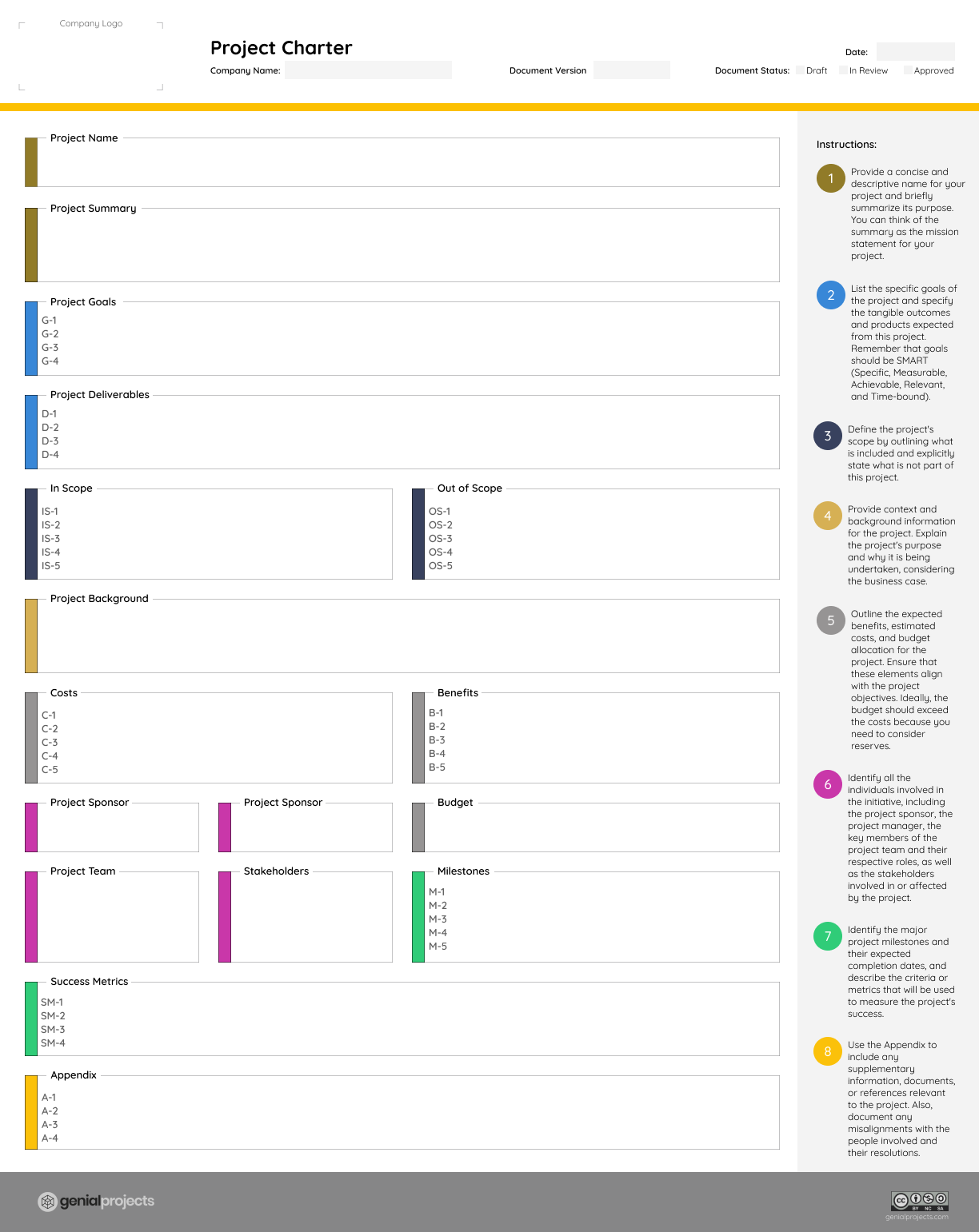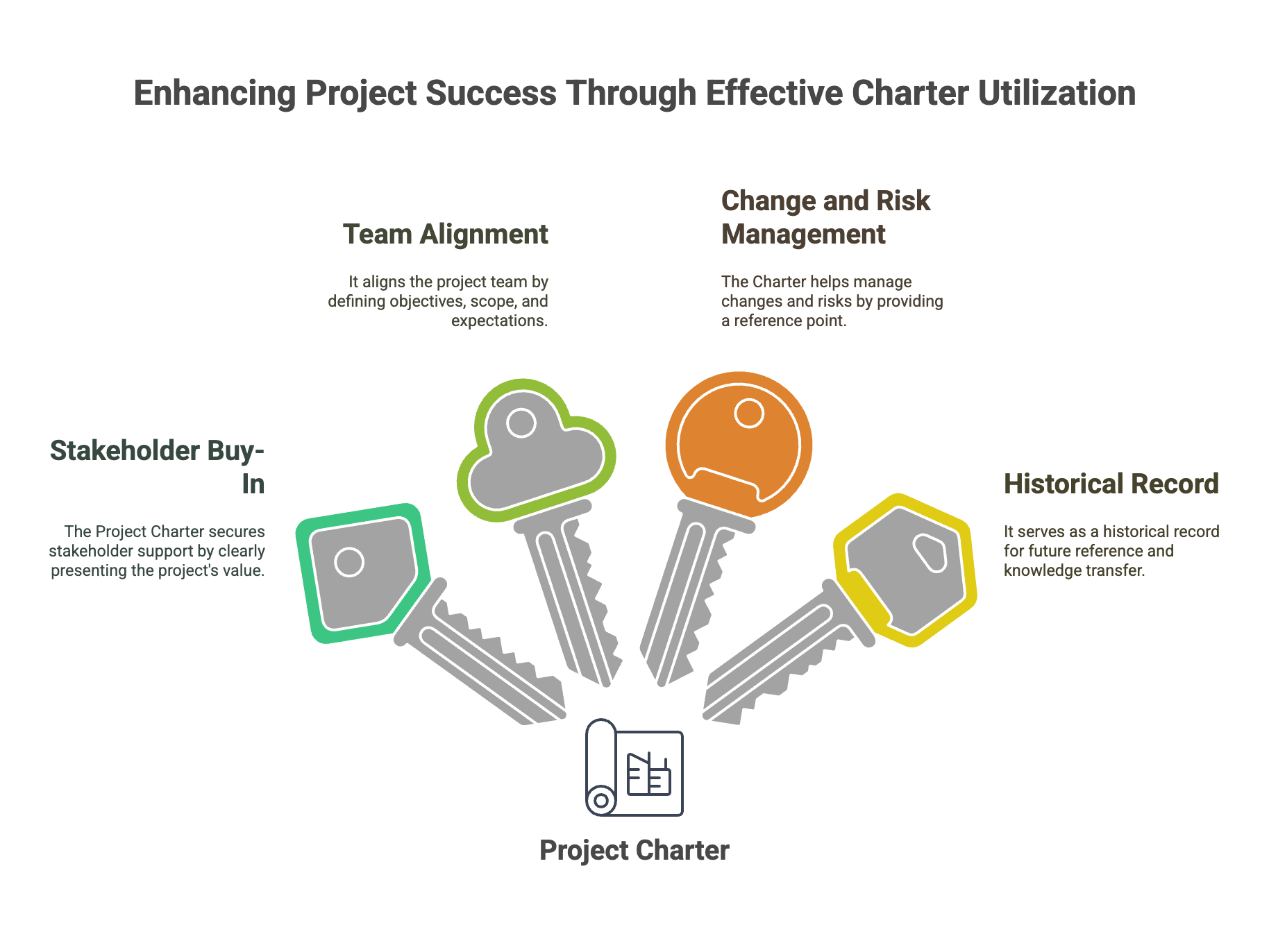Project success begins with a well-crafted Project Charter. In this article, we will delve into the intricacies of Project Charters, the essential tool that defines the path to project success. Whether you're a seasoned Project Manager, a budding entrepreneur, or a C-level executive, understanding and mastering the Project Charter is crucial for effective project delivery.
What is a Project Charter and why you need one?
A Project Charter is a formal document prepared by the Project Manager, serving as the North Star for the project's journey. It distinctly outlines the project and provides the necessary details to achieve its objectives. This document is pivotal for various reasons, such as setting expectations, aligning stakeholders, and ensuring clarity. It acts as a guiding force throughout the project's lifecycle, helping the project team stay on course and fostering a common understanding of the project's purpose.
Project Charter vs Project Proposal
It's essential to distinguish between a Project Charter and a Project Proposal. While both are essential in project management, they serve different purposes. A Project Proposal is a persuasive document aimed at convincing stakeholders to initiate a project. It outlines the benefits of the project and the rationale behind it, essentially seeking approval. On the other hand, a Project Charter is an authoritative document that follows the approval of the Project Proposal. It sets the stage for project execution by defining its scope, objectives, stakeholders, and other critical components.
Key elements of a Project Charter

A Project Charter can be a document of many pages or just a few, with more or fewer sections, depending on the project's complexity, the context in which the initiative takes place, and the established processes within the organization for this purpose. At Genialprojects, we recommend that the Project Charter be a document of at most a couple of pages and include, at a minimum, the following sections:
Project Name: The Project Name is the project's official identifier, making it easy for all involved parties to refer to it. It should be clear, concise, and representative of the project's purpose.
Project Summary: A Project Summary provides a brief yet comprehensive overview of the project. It acts as a quick reference point for stakeholders and team members, outlining the project's essence.
Project Goals: Clearly defined Project Goals are the foundation of your Project Charter. They specify what the project aims to achieve and help stakeholders understand its purpose.
Project Deliverables: Project Deliverables are tangible outcomes or results that the project will produce. They define what success will look like and provide a clear focus for the project team.
Project Scope: Project Scope outlines the boundaries of the project. It clarifies what's included and what's excluded, helping to prevent scope creep and maintain project focus.
Project Background: The Project Background section provides context, detailing the reasons for initiating the project. It often connects with the business case, shedding light on the project's relevance.
Project Benefits: Identifying the expected benefits of the project is crucial. These benefits serve as the motivators for project stakeholders and contribute to overall project success.
Project Costs: Project Costs encompass a high-level estimate of the financial resources required for the project. It's crucial to have a rough cost estimate early on to secure the necessary budget.
Budget: The Budget section specifies the allocated funds for the project. Ideally, the budget should exceed the estimated costs to accommodate contingencies.
Project People: Listing the key individuals involved in the project, including the Project Manager, Project Sponsor, stakeholders, and project team, ensures clarity in roles and responsibilities.
Milestones: Milestones are crucial checkpoints during the project's execution. They help monitor progress and ensure the project stays on track.
Appendix: The Appendix section holds additional information, documents, or references relevant to the project. It also documents any discrepancies with involved parties and their resolutions.
Crafting a Project Charter
Crafting a Project Charter is not a one-size-fits-all process. It requires the Project Manager to understand the project's context, engage with stakeholders, and document the essential information. This dynamic process involves effective communication, negotiation, and alignment with project sponsors to ensure a well-structured and purposeful Project Charter.
Using the Project Charter
Gaining Stakeholders Buy-In
The Project Charter plays a pivotal role in gaining stakeholders' buy-in. By providing a clear and comprehensive view of the project, it ensures that stakeholders understand the project's value, leading to their support and commitment.
Uncovering details of the project with your team
For the project team, the Project Charter serves as a foundational document. It clarifies the project's objectives, scope, and expectations, enabling the team to work cohesively toward a common goal.
Managing Changes and Risks with Your Charter
Change is inevitable in any project. The Project Charter helps in managing changes by providing a reference point to evaluate proposed alterations and their impact on the project's success. Additionally, it aids in identifying and addressing risks early on, mitigating potential setbacks.
Providing a historical record
A well-maintained Project Charter becomes a historical record of the project's journey. It can be used for reference in future projects, facilitating knowledge transfer and enhancing future project management practices.

Agile Project Management and Project Charters
While Project Charters have roots in traditional project management, they remain highly relevant in Agile and Hybrid Project Management approaches. The adaptability and clarity provided by a Project Charter can be invaluable in the ever-changing landscape of Agile projects. Agile teams can use it as a foundational document to ensure alignment, manage expectations, and deliver successful outcomes.
Key takeaways
- A Project Charter is your project's blueprint for success, offering clarity and alignment.
- It differs from a Project Proposal, which is aimed at persuading stakeholders to start a project.
- Key elements, such as Project Goals, Deliverables, and Costs, are integral to a well-crafted Project Charter.
- Crafting a Project Charter is a dynamic process that requires effective communication and negotiation.
- The Project Charter's uses include gaining stakeholder buy-in, guiding the project team, managing changes and risks, and providing a historical record.
- Project Charters are not limited to traditional project management; they are adaptable and valuable in agile project management.
In conclusion, mastering the art of Project Charters is an essential skill for project success. This foundational document is a versatile tool that bridges the gap between project initiation and successful delivery. Whether you're embarking on a traditional project or navigating the agile landscape, the Project Charter remains a steadfast companion on the road to project excellence. So, begin your project journey with a well-crafted Project Charter, and watch your project's success unfold.